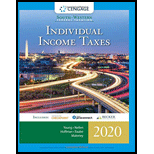
Individual Income Taxes
43rd Edition
ISBN: 9780357109731
Author: Hoffman
Publisher: CENGAGE LEARNING - CONSIGNMENT
expand_more
expand_more
format_list_bulleted
Concept explainers
Question
Chapter 19, Problem 50P
a.
To determine
Explain about the tax consequences to person G and the Bank.
b.
To determine
Explain about the tax consequences to person G and the Bank for the situation given.
Expert Solution & Answer
Want to see the full answer?
Check out a sample textbook solution
Students have asked these similar questions
A firm is planning for its financing needs and uses the basic fixed-order-quantity inventory model (EOQ). What is the total cost (TC), including purchasing cost, of the inventory given an annual demand of 12,000 units, ordering cost of $40, a holding cost per unit per year of $5, an EOQ of 500 units, and a cost per unit of inventory of $120?
Question
What is the estimated ending inventory
Chapter 19 Solutions
Individual Income Taxes
Ch. 19 - Prob. 1DQCh. 19 - Prob. 2DQCh. 19 - Prob. 3DQCh. 19 - Prob. 4DQCh. 19 - Prob. 5DQCh. 19 - Prob. 6DQCh. 19 - Prob. 7DQCh. 19 - Prob. 8DQCh. 19 - Prob. 9DQCh. 19 - Prob. 10DQ
Ch. 19 - Prob. 11DQCh. 19 - Prob. 12DQCh. 19 - Prob. 13DQCh. 19 - Prob. 14CECh. 19 - Prob. 15CECh. 19 - Prob. 16CECh. 19 - Prob. 17CECh. 19 - Zack, a sole proprietor, has earned income of...Ch. 19 - Prob. 19CECh. 19 - Prob. 20CECh. 19 - Prob. 21CECh. 19 - Prob. 22CECh. 19 - Prob. 23CECh. 19 - Prob. 24CECh. 19 - Prob. 25CECh. 19 - On April 5, 2017, Gustavo was granted an NQSO for...Ch. 19 - Prob. 27PCh. 19 - Prob. 28PCh. 19 - Prob. 29PCh. 19 - Prob. 30PCh. 19 - Prob. 31PCh. 19 - Prob. 32PCh. 19 - Prob. 33PCh. 19 - Prob. 34PCh. 19 - In 2019, Magenta Corporation paid compensation of...Ch. 19 - Prob. 36PCh. 19 - Prob. 37PCh. 19 - Prob. 38PCh. 19 - Prob. 39PCh. 19 - Prob. 40PCh. 19 - Prob. 41PCh. 19 - Prob. 42PCh. 19 - Prob. 43PCh. 19 - Prob. 44PCh. 19 - Carri and Dane, ages 34 and 32, respectively, have...Ch. 19 - Prob. 46PCh. 19 - Prob. 47PCh. 19 - Prob. 48PCh. 19 - Prob. 49PCh. 19 - Prob. 50PCh. 19 - Prob. 51PCh. 19 - Prob. 52PCh. 19 - Prob. 53PCh. 19 - Prob. 54PCh. 19 - Prob. 55PCh. 19 - Prob. 56PCh. 19 - Prob. 57PCh. 19 - Prob. 1RPCh. 19 - Prob. 2RPCh. 19 - Prob. 3RPCh. 19 - Prob. 6RPCh. 19 - Prob. 8RPCh. 19 - Prob. 1CPACh. 19 - Ryan is 39 years old and works as a real estate...Ch. 19 - Prob. 3CPACh. 19 - Prob. 4CPA
Knowledge Booster
Learn more about
Need a deep-dive on the concept behind this application? Look no further. Learn more about this topic, accounting and related others by exploring similar questions and additional content below.Similar questions
- Gimpy Corp. has variable costs that are 75% of sales, current sales of $800,000, and fixed costs of $150,000. What is the required sales amount to achieve a $85,000 net income? Answerarrow_forwardPlease give me true answer this financial accounting questionarrow_forwardHow much cash disbursement for Material purchase be?arrow_forward
- answer plzarrow_forwardSummit Enterprises had a pre-tax accountingarrow_forwardCorruption Please response to the following: Describe the four types of corruption: conflicts of interest, economic extortion, unlawful gratuities, and bribery. Which one is more difficult to discover during an inquiry, in your opinion, and why? Make sure to reply to at least one post made by one of your classmates.arrow_forward
arrow_back_ios
SEE MORE QUESTIONS
arrow_forward_ios
Recommended textbooks for you
 Individual Income TaxesAccountingISBN:9780357109731Author:HoffmanPublisher:CENGAGE LEARNING - CONSIGNMENT
Individual Income TaxesAccountingISBN:9780357109731Author:HoffmanPublisher:CENGAGE LEARNING - CONSIGNMENT


Individual Income Taxes
Accounting
ISBN:9780357109731
Author:Hoffman
Publisher:CENGAGE LEARNING - CONSIGNMENT



